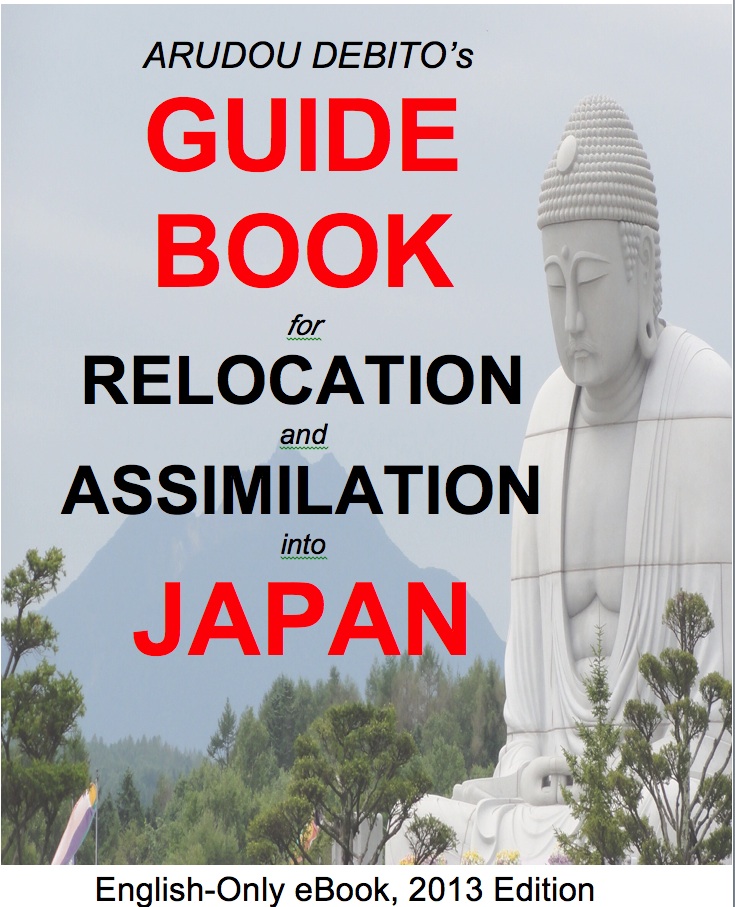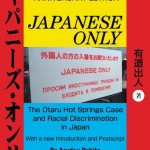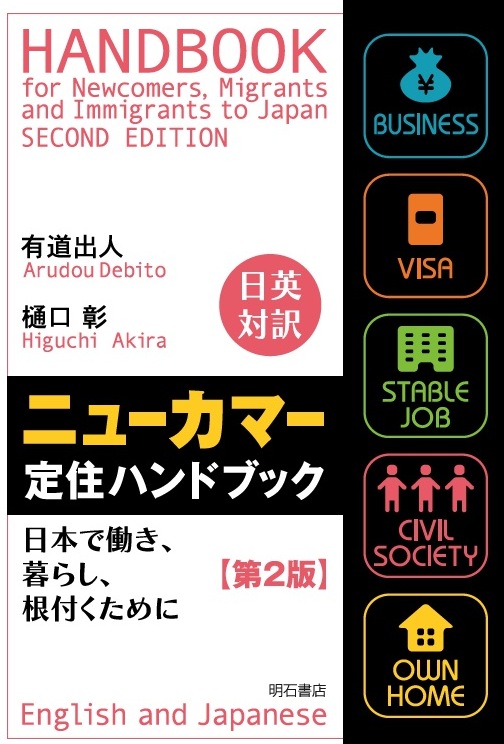mytest
eBooks, Books, and more from ARUDOU, Debito (click on icon):





![]()


UPDATES ON TWITTER: arudoudebito
DEBITO.ORG PODCASTS on iTunes, subscribe free
“LIKE” US on Facebook at http://www.facebook.com/debitoorg
http://www.facebook.com/handbookimmigrants
https://www.facebook.com/JapaneseOnlyTheBook
https://www.facebook.com/BookInAppropriate
If you like what you read and discuss on Debito.org, please consider helping us stop hackers and defray maintenance costs with a little donation via my webhoster:

All donations go towards website costs only. Thanks for your support!
Hi Blog. Here’s my August Japan Times column, bumped a week due to Colin Jones’s excellent column on the topic I open up with.
////////////////////////////////////////////////////
Past victimhood blinds Japan to present-day racial discrimination
Like the abused who then go on to abuse, Japan is too psychologically scarred to see discrimination going on within its borders
BY DEBITO ARUDOU
Japan Times JUST BE CAUSE Column 78, August 14, 2014
Readers may be expecting this column to have something to say about the Supreme Court decision of July 18, which decreed that non-Japanese (NJ) residents are not guaranteed social welfare benefits.
But many have already expressed shock and outrage on these pages, pointing out the injustice of paying into a system that may choose to exclude them in their time of need. After all, no explicit law means no absolute guarantee of legal protection, no matter what court or bureaucratic precedents may have been established.
I’m more surprised by the lack of outrage at a similar legal regime running parallel to this: Japan’s lack of a law protecting against racial discrimination (RD). It affects people on a daily basis, yet is accepted as part of “normal” unequal treatment in Japan — and not just of noncitizens, either.
This brings me to an argument I wanted to round off from last month’s column, about how Japan has a hard time admitting RD ever happens here. Some argue it’s because RD does not befit Japan’s self-image as a “civilized” society. But I would go one step further (natch) and say: RD makes people go crazy.
First, let me establish the “hard time admitting it” bit. (Apologies for reprising some old ground.)
As covered in past columns, Japan’s government and media are seemingly allergic to calling discriminatory treatment based upon skin color or “foreign” appearance racial discrimination (specifically, jinshu sabetsu).
For example, take the Otaru onsen case (1993-2005), which revolved around “Japanese only” signs barring entry to hot springs in Otaru, Hokkaido, to anyone who didn’t “look Japanese” enough (including this writer). Only one major Japanese media source, out of hundreds that reported on it, referred to jinshu sabetsu as an objective fact of the case (rather than reporting it as one side’s claim) — even after both the Sapporo district and high courts unequivocally adjudged it as such.
Public discourse still shies away from the term. That is why the reaction to the “Japanese only” banner displayed at the Urawa Reds soccer game in March was such a landmark. After initial wavering (and the probable realization that the World Cup was approaching), the team’s management, the J. League and the media in general specifically called it out as jinshu sabetsu, then came down on it with unprecedented severity.
Bravo. Thank you. But so far, it’s the exception that proves the rule.
This see-no-evil attitude even affects scholarship on Japan, as I discovered during my doctoral dissertation literature review. Within the most-cited sources reviewing discrimination in Japan, not one listed “skin color” as among Japan’s discriminatory stigmata, or included RD as a factor (calling it instead discrimination by nationality, ethnicity, ingrained cultural practice, etc.). Indicatively, none of them (except some obscure law journal articles) mentioned the Otaru onsen ruling either.
Now peer into Japan’s education system. Jinshu sabetsu happens anywhere but Japan. The prototypical examples are the American South under segregation and apartheid-era South Africa. But homogeneous Japan, the argument runs, has no races, therefore it cannot logically practice racial discrimination. (Again, the Otaru onsen ruling disproves that. But, again, see no evil.)
So why can’t Japan own up? Because RD inflicts such deep psychological wounds that whole societies do irrational, paranoid and crazy things.
Consider this: Harvard University anthropologist Ayu Majima, whose chapter in Rotem Kowner and Walter Demel’s 2013 book “Race and Racism in Modern East Asia” I cited last month, also discussed the aftermath of the United States’ Asian exclusion policy of 1924 — under which Japan, despite all its attempts to “Westernize” and “de-Asianize” itself, was subordinated as a “colored” nation.
Japan’s public reaction was (understandably) furious, and visceral. The Kokumin Shimbun called it “a national dishonor” and demanded that U.S.-Japan ties be severed. In the words of one liberal Japanese journalist at the time: “Discrimination from the United States was due to regarding the Japanese as a colored people. This is a disgrace to the most delicate matter of the Japanese ethnic pride.”
Public outcry morphed into mass hysteria, including countless letters to the government urging war on America. Several people even committed suicide outside the American Embassy!
Although these events subsided, Japan’s elites never let go of this slur. The Japanese ambassador wrote the U.S. secretary of state, saying that the issue was “whether Japan as a nation is or is not entitled to the proper respect” that forms “the basis of amicable international intercourse throughout the civilized world.” Emperor Hirohito later called the act “a remote cause of the Pacific War.” It has also been connected to Japan’s rejection of the West and invasion of Manchuria.
See how crazy RD makes people? Mass hysteria? Calls for war? Suicides? International isolation? Invading China?
RD also psychologically wounds people to the point that it can feed illogical exceptionalism, denialism and perpetual victim status.
It short-circuits the ability to run self-diagnostics and see the fundamental hypocrisy behind the idea that, for example, Japanese are perpetual victims of RD, but rarely, if ever, perpetrators of it — as if Japan is somehow an exception from the racialization processes that happen in every society.
Seriously. During Japan’s colonial era, when Japan was “liberating” and colonizing its neighbors under the Greater East Asian Co-Prosperity Sphere, officials argued that under Japan’s Pan-Asianism, where (unlike Western colonization) her new subjects were of the same skin color, Japan could not practice “racism” in the Western sense.
Source: Oguma Eiji, A Genealogy of “Japanese” Self-Images, 2002, pg. 332-3.
But the historical record indicates that Japan’s colonized subalterns were subordinated and exploited like any racialized minority — something Japan’s similarly psychologically-wounded neighbors have never forgotten.
Then, in the postwar period, Japan’s national narrative mutated from “heterogeneous Asian colonizer” to “pure homogeneous society.” How did official illogic accommodate this shift? Again, with fallacious ideas such as “Japan has no races, therefore it cannot possibly practice racism.”
This claim is easily disproven by pointing to the country’s “Japanese only” signs. But then what happens? Relativism, denialism and counterattack.
Either deniers repeat that Japan has no RD (patently false; again, that pesky Otaru onsen case), or they argue that everyone else in the world is racist and Japanese have been victims of it (citing wartime examples such as the U.S. and Canadian Japanese internment camps, or the atomic bombings) — as if racism is just how the world naturally functions, and two wrongs make a right.
Then the focus turns on you. You face accusations of racism for overgeneralizing about Japan (e.g., with the counterargument that only a few places post “Japanese only” signs — just don’t point out the standard practice of denying NJ apartments . . .). Or you are charged with being remiss for not acknowledging the “positive discrimination” that “esteemed NJ” get (some, that is), and that positive discrimination somehow compensates for and justifies the negative. Then the debate gets tangled in red herrings.
But the point is that the reaction will be as swift, clear and visceral as it was way back when. The milder accusations will be of cultural insensitivity, Japan-bashing or Japan-hating. But as you get closer to the heart of the matter, and the incontrovertible evidence moves from anecdotal to statistical, you’ll be ostracized, slandered, harassed by Japan’s shadowy elements, stalked and issued death threats. Believe me, I know.
Again, racism is not seen as something that “civilized” countries like Japan would do. To call it out is to question Japan’s level of civilization. And it conjures up an irrational denialism wrapped within a historical narrative of racialized victimization.
Thus Japan’s constant self-victimization leads to paranoia and overreaction (justifying even more tangential craziness, such as defenses of whaling and dolphin culls, international child kidnappings after divorce, and historical amnesia) due in part to fears of being besmirched and discriminated against again. Like a jilted suitor heartbroken by an exotic lover, Japan thus takes extreme precautions to avoid ever being hurt again — by forever forsaking close, equal and potentially vulnerable relationships with anyone with a whiff of the exotic.
Until Japan gets over itself and accepts that racialization processes are intrinsic to every society, it will never resolve its constant and unwarranted exceptionalism. Bigots must be dealt with, not denied or justified. Like the abused who becomes the abuser, Japanese society is simply too psychologically damaged by RD to stop its RD.
This remains the fundamental hurdle Japanese society must overcome before it can empathize fully with outsiders as fellow equal human beings. As was evident in last month’s Supreme Court ruling.
There — now you have my comment on it.
================================
Debito Arudou’s most recent publication is the Hokkaido and Tohoku Chapters in Fodor’s 2014 Japan travel guide. Twitter: @arudoudebito. An excerpt of Ayu Majima’s chapter can be read at www.debito.org/?p=12122, and more of Debito’s analysis of the Supreme Court ruling at www.debito.org/?p=12530. Just Be Cause usually appears in print on the first Thursday of the month. Your comments: community@japantimes.co.jp
9 comments on “My Japan Times JUST BE CAUSE column 78, August 14, 2014, “Past victimhood blinds Japan to present-day racial discrimination””
“illogical exceptionalism, denialism and perpetual victim status”
Finally a clear statement on how it is here every single time you try to talk about Japan, with Japanese, in Japan.
Snap – Luca -read my mind. Ever since the “Black Ships” (irony?) Japan has been in perpetual victim mode status.
Yet the national daily discourse is riddled with global and racial pecking order paranoia and national characteristics nihonjinron myth-making. Do I have to give examples?
Every day, the message seems drummed in; Japanese are kind and civilized and superior to “developing nations” and yet always being bullied at the same time. Japanese are unique and special, and no one understands them because of their different DNA and island culture, which is impenetrable for other races to understand (assuming Japanese people are a “race”) yet at the same time are not, actually cannot be racist.
These sorts of ludicrous contradictions obviously do so much to cripple logical discourse and thinking.
Oh, a tangent, very interesting news item on NHK last night. So much for Japanese being some sort of “pure Yamato race” with the discovery of what looks like a Soga clan bigwig buried in a Koguryo (高句麗) Korean style pyramid burial mound. Of course, in a sane society you’d think the idea of the Imperial family coming from Korea except that, to his credit, Akihito publicly admitted it back in 2001.
I talked to my (Japanese) wife about the Koguryo-style kofun as we were watching it on the news and her response was “Japanese history is mainly lies.” Simple answer, and not entirely wrong, IMO.
Finally, I got the aha(!) moment after reading the article. Japan’s perpetuating status of cultural uniqueness is a by-product of realism that attempts to reveal the true nature of things in addressing public issues. It’s the same sort of default rhetoric pro-free marketers like to deploy as their economic argument for justifying proliferation of privatization as a standard cultural practice. Rhetorical theorist James Arnt Aune(which was my late former college mentor) suggests that realist economic style works for powers-that-be to promote their market-based talk as authentic discourse “by radically separating power and textuality, constructing the political realm as a state of nature, and by depicting its opponents as prisoners of verbal illusions.” It is at this point that political founders and defenders of Japan’s cultural uniqueness use the same logic by equating national public culture with market talk. Note that we can see GOJ’s Tomodachi Newsletters under the name of ABEarson Inc. as an example of promoting the nation as commodity product in the international market.
What’s remarkable with realistic nature of Japan’s cultural uniqueness argument is that it goes hand in hand with abusive use of victimhood discourse—a.k.a. , denial of membership for international league. It is telling that such shocking moment of exclusion from the league table conflated nationality into the discourse of race/ethnicity, for ideological framing of discrimination under the name of rational distinction—which dispenses with pretenses like market talk. No doubt that has given some people justification for false accusation of NJ for discrimination by race on one hand, but exoneration from any moral responsibility for racially motivated conducts that will affect the lives of NJ
on the other.
@All – Please learn how America stopped Apartheid in South Africa:
http://en.wikipedia.org/wiki/Comprehensive_Anti-Apartheid_Act
http://www.gpo.gov/fdsys/pkg/STATUTE-100/pdf/STATUTE-100-Pg1086.pdf
Take that law, replace South Africa with Japan, make a few edits, send to your Senator.
And Debito, your most recent article really hits home, as an American with Jewish-ancestry.
Zionist and Japanese culture both claim victimhood while killing “goyim” and “gaijin” using Apartheid systems.
And before someone claims Japan isn’t killing, let’s remember 10 killed “gaijin” killed in Japan:
Abubakar Awudu Suraj
Bishnu Prasad Dhamala
Lucie Jane Blackman
Lindsay Ann Hawker
Richard Scott Tucker
Hoon Scott Kang
Matthew Matt Lacey
David James Floyd
Herculano Reiko Lukocevicius
Honiefaith Ratilla Kamiosawa
R.I.P.
See, Japanese citizens are not scared to kill “gaijin” when the Japanese Apartheid system exists.
Just as Israeli citizens are not scared to kill “goyim” when the Israeli Apartheid system exists.
This is an area that I am interested in, so let me supplement FaithnoMore’s comments with links. I realize that this is largely off topic, so I will refrain from any more comments about it here.
都塚古墳は“ピラミッド型”か
http://www3.nhk.or.jp/news/html/20140813/k10013784831000.html
都塚古墳 特異な墳丘 論議呼ぶ
http://www.yomiuri.co.jp/local/nara/news/20140813-OYTNT50262.html
Pyramid-Shaped Tomb Revealed in Japan
http://www.archaeology.org/news/2433-140814-japan-pyramid-like-tomb-revealed
Great article Dr. Debito!
As usual, the JT apologists try the same defamation, and deflection games.
But, the point is, that you are right, and the number of voices that relate to your column based on personal experience continues to grow.
One commenter made an interesting point about not buying Japanese, and the way that modern media has exposed ‘brand Japan’ to the splash-back to Japan’s discriminatory and xenophobic policies.
An interesting twist/tangent to this on the beeb website:
“Disability and the Japanese art of mastering chopsticks…”*
“…Michael Peckitt is a UK national who has been living in Japan for two years. He has cerebral palsy and, a little shaky himself, believes that holding chopsticks in a non-standard way is viewed as a “social deviance”…”
* http://www.bbc.com/news/blogs-ouch-28646082
@All and especially #4 on ‘How America stopped apartheid’
It is ridiculous and insulting to compare Japan with apartheid-era South Africa. It is also ridiculous and insulting to attribute anything, but the merest support, to the ending of white minority rule in South Africa by the US government.
In actual fact the courageous black people of South Africa freed themselves from apartheid together with their vanguard organisations including the ANC, PAC, BCM and the South African Communist Party. Many governments, most notably Reagan/Thatcher, gave enormous support not only to the racist government in Pretoria but also to UNITA in Angola, RENAMO in Mozambique and anti SWAPO forces in Namibia.
The legal foundations for apartheid were laid after the 1948 general election. That the first apartheid law enacted in 1950 was followed 36 years later by the only US law concerned with SA says more than enough about the US government’s contribution to the downfall of apartheid.
— Counterpoint taken. And we’ll stop this tangent here, thanks for posting.
Who’s this fellow, and what’s he on about? (I can read only a little Japanese, but this looks intriguing.)
http://bylines.news.yahoo.co.jp/nishantha/20140818-00038350/
日本人のあなたが外国人として逮捕される日。